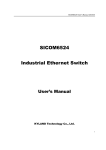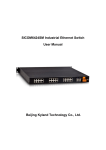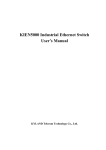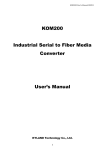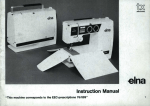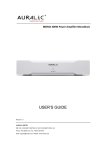Download SICOM2024M Industrial Ethernet Switch User`s Manual
Transcript
SICOM2024M User’s Manual 201008 SICOM2024M Industrial Ethernet Switch User’s Manual KYLAND Technology Co., Ltd. SICOM2024M User’s Manual 201008 SICOM2024M Industrial Ethernet Switch User’s Manual Copyright © 2009 KYLAND Technology CO., LTD. All rights reserved. No part of this documentation may be excerpted, reproduced, translated, annotated or duplicated, in any form or by any means without the prior written permission of KYLAND Corporation. Publisher: KYLAND Technology CO., LTD. Address: Chongxin Creative Building, Shixing East Road 18#, Shijingshan District, Beijing, China Website: http://www.kyland.cn Postcode: 100041 Tel: (+8610) 88796676 FAX: (+8610) 88796678 E‐mail: [email protected] Version: V1, Apr. 2009 V2, Feb. 2010 No.: 27030033‐11 SICOM2024M User’s Manual 201008 Preface SICOM2024M is a high‐performance industrial Ethernet switch specially designed by KYLAND Technology CO., LTD. for industrial applications. Its high‐performance switch engine, solid and sealed case design, single ribbed fanless case for high efficient heat dissipation, overcurrent, overvoltage and EMC protection at power input terminal, and excellent EMC protection of RJ45 port make SICOM2024M applicable in harsh and dangerous industrial environments. Fiber network redundancy function, redundant power inputs and power alarm functions provide multi‐supports for reliable operation of the system. The user’s manual for SICOM2024M Industrial Ethernet Switch mainly introduces the technical principles, performance indexes, installation and commissioning, etc. It is a reference for users in system startup, expansion and routine maintenance. It is also a practical teaching material for user training and technician study. This manual mainly includes the following contents: Chapter 1 Overview and system features of SICOM2024M; Chapter 2 Performance and service functions of SICOM2024M; Chapter 3 Hardware structure of SICOM2024M; Chapter 4 Installation of SICOM2024M; Chapter 5 Field test methods for SICOM2024M; Chapter 6 Network topology and system configuration of SICOM2024M; Appendix A Introduces twisted pair and pin distribution rules of SICOM2024M; Appendix B Introduces cable types and specifications of SICOM2024M; Appendix C Introduces abbreviations used in this manual. Statement: As product and technology upgrades and improves constantly, the contents of this document may not completely accord with the actual product. For product upgrading information, please visit our company’s website or directly contact with our business representative. SICOM2024M User’s Manual 201008 Notice for Safety Operation This product performs reliably as long as it is used according to the guidance. Artificial damage or destruction of the equipment should be avoided. z Read this manual carefully and keep it for future reference; z Do not place the equipments near water sources or humid places; z Do not place anything on power cable and put the cable in unreachable places; z Do not tie or wrap the cable to prevent fire. z Power connectors and other equipment connectors should be firmly interconnected and frequently checked. In the following cases, please immediately cut off the power supply and contact our company: 1. Water gets into the equipments; 2. Equipment damage or shell breakage; 3. Abnormal operation conditions of equipment or the demonstrated performances have changed; 4. The equipment emits odor, smoke or makes noise. z Please keep optical fiber plugs and sockets clean. During the operation of equipments, do not look directly at the cross section of optical fiber; z Please keep the equipment clean; if necessary, wipe the equipment with soft cotton cloth; z Do not repair the equipment by yourself, unless it is clearly specified in the manual. Explanation of Warning Marks: This manual uses two kinds of noticeable warning signs to arouse special attention of users during operation. The implications of these signs are as follows: SICOM2024M User’s Manual 201008 Warning: pay special attention to the notes behind the mark, improper operation will lead to serious damage of the switch or injury of the operating personnel. Caution, attention, danger: remind the operators places that need to pay attention to. SICOM2024M User’s Manual 201008 Contents Chapter 1: System Overview ................................................................................................................................................... 8 1.1 Product Overview ....................................................................................................................................................... 8 1.2 Product Features ......................................................................................................................................................... 8 1.3 Packing list and unpacking check ......................................................................................................................... 9 Chapter 2: Performance Specifications ....................................................................................................................... ‐ 10 ‐ 2.1 System Specifications ........................................................................................................................................ ‐ 10 ‐ 2.2 Service Interface .................................................................................................................................................. ‐ 11 ‐ Chapter 3: Hardware Structure ...................................................................................................................................... ‐ 12 ‐ 3.1 System Structure ................................................................................................................................................. ‐ 12 ‐ 3.2 Device Structure .................................................................................................................................................. ‐ 12 ‐ 3.2.1Case ............................................................................................................................................................... ‐ 12 ‐ 3.2.2 Front Panel ............................................................................................................................................... ‐ 13 ‐ 3.2.3 Rear Panel ................................................................................................................................................ ‐ 14 ‐ Chapter 4 Hardware Installation ................................................................................................................................... ‐ 18 ‐ 4.1 Installation requirement .................................................................................................................................. ‐ 18 ‐ 4.2 Installation ............................................................................................................................................................. ‐ 18 ‐ 4.3 Cable Connection................................................................................................................................................. ‐ 19 ‐ 4.4 Optical Fiber Connection ................................................................................................................................. ‐ 20 ‐ 4.5 Cable Wiring .......................................................................................................................................................... ‐ 20 ‐ Chapter 5: Test Methods ................................................................................................................................................... ‐ 22 ‐ 5.1 Self inspection ...................................................................................................................................................... ‐ 22 ‐ 5.2 TP Port Test ........................................................................................................................................................... ‐ 22 ‐ 5. 3 Fiber Port Test ..................................................................................................................................................... ‐ 22 ‐ Chapter 6: Networking and Configurations .............................................................................................................. ‐ 24 ‐ 6.1 Networking ............................................................................................................................................................ ‐ 24 ‐ 6.2 System configuration ......................................................................................................................................... ‐ 24 ‐ SICOM2024M User’s Manual 201008 Appendix A: Twisted‐pair and Pin Distribution ...................................................................................................... ‐ 26 ‐ Appendix B: Cable Type and Specifications .............................................................................................................. ‐ 29 ‐ Appendix C: Glossary ................................................................................................................................................................ 30 SICOM2024M User’s Manual 201008 Chapter 1: System Overview 1.1 Product Overview SICOM2024M is a high‐performance industrial Ethernet switch specially designed by KYLAND Technology CO., LTD. for industrial applications. Its high‐performance switch engine, solid and sealed case design, single ribbed fanless case for high efficient heat dissipation, overcurrent, overvoltage and EMC protection at power input terminal, and excellent EMC protection of RJ45 port make SICOM2024M applicable in harsh and dangerous industrial environments. Fiber network redundancy function, redundant power inputs and power alarm functions provide multi‐supports for reliable operation of the system. SICOM2024M series industrial Ethernet switch have strong network management function which support CLI, Telnet, WEB, SNMP‐based network management software. SICOM2024M supports 19 inch 1U rack mounting and provides 24 10/100Base‐TX ports and one or two pairs of 100Base‐FX single mode of multi mode fiber ports. Each RJ45 port has self‐adaptive function, making it automatically configured to 10Base‐T/100Base‐TX, full/half duplex mode and MDI/MDI‐X auto‐connection. 1.2 Product Features 1. High performance industrial Ethernet switch z 24 10/100Base‐TX, self‐adaptive Ethernet ports (full/half duplex), supports auto MDI/MDI‐X connection z 2 pairs of 100Base‐FX full duplex multi mode/single mode redundant fiber ports z IEEE802.3/802.3U/802.3X, store and forward switching mode z Supports various management methods for user’s easy management, such as WEB, CLI, TELNET, SNMP, OPC z Supports port flow control, VLAN/PVLAN, port mirroring, port trunking, link status check, IGMP Snooping, ACL, ARP, SNMP, RSTP, RSTP transparent transmission, QoS, unicast address configuration and query configuration 2. z Supports power alarm, IP collision alarm, MAC collision alarm, port alarm functions z FTP‐based online software update, easy for user’s device management and renewal Industrial Power Design SICOM2024M User’s Manual 201008 Support industrial power input: 24VDC (18~36VDC), 48VDC (36~72VDC), 110VDC (82~185VDC), 220VAC/DC (85~264VAC/120~370VDC), dual redundant power inputs Power input with over‐current, over‐voltage and EMC protection 3. Rugged design Single‐ribbed aluminum case design for heat dissipation (no fans); reliable operation at ‐40℃ to +85℃ Solid and sealed aluminum case with IP40 protection class, and is able to work in harsh and dangerous industrial environments 1.3 Packing list and unpacking check 1. Packing list Please refer to the packing list 2. Unpacking check Before opening the case, place it stably, pay attention to the direction of the packing case and ensure its right side is facing upward, so as to prevent SICOM2024M falling from the case after opening it. If using a hard object to open the case, do not over extend the hard object into the case to avoid damage of the equipments inside it. After opening the case, please check the amount of SICOM2024M equipments according to the packing list and check the appearance quality of SICOM2024M. Warning: For the built‐in precise parts of the equipment, please handle with care and avoid strenuous vibration to avoid affecting the performances of equipments. SICOM2024M User’s Manual 201008 Chapter 2: Performance Specifications 2.1 System Specifications The system performance specifications of SICOM2024M industrial Ethernet switch are shown in Table 2‐1. Table 2‐1 System Specifications Specifications Quantity of RJ45 port Quantity of 100M fiber ports SICOM2024M 24×10 /100Base‐TX 2×100Base‐FX‐SM/MM Standards: IEEE802.3, IEEE 802.3x, IEEE 802.3u, IEEE 802.1w, IEEE 802.1d, IEEE 802.1p, IEEE 802.1q Max. Store‐and‐Forward speed: 148810pps; Max. filtering speed: 148810pps System performance Switching mode: Store‐and‐Forward System switching bandwidth: 8.8G Electromagnetic compatibility interference: EN55022 Electromagnetic compatibility immunity: EN50082‐2 Physical port: shielded RJ45 TP port parameters RJ45 port: 10/100Base‐TX, supporting auto‐negotiation Port standard: in line with IEEE802.3 standard Transmission distance: <100m Optical power: >‐13dbm (SM) >‐20dbm (MM) Receiving sensitivity: <‐28dbm (SM) <‐35dbm (MM) Fiber port parameters Wave length: 1310nm (SM) 1550nm (SM) 1310 nm (MM) Transmission distance: 40~80km (SM) <5km (MM) Connector type: SC/FC/ST Transmission speed: 125Mbps (100M) Input voltage: 24VDC (18~36VDC), 48VDC (36~72VDC), 110VDC (82~185VDC), Power supply 220VAC/DC (85~264VAC/120~370VDC) Input power consumption: <15W Over‐current Protection: built‐in Mechanical parameters Physical dimensions (W×H×D): 482.6mm×44mm×245mm SICOM2024M User’s Manual 201008 Mounting mode: 19 inch 1U rack mounting Heat removal method: Single‐ribbed aluminum case without fans. Outlet type: Back outlet Shell protection class: IP40 Weight: 2.5kg Operating temperature: ‐40℃~85℃ Storage temperature: ‐40℃~85℃ Ambient conditions Humidity: 0~95% (non‐condensing) 2.2 Service Interface 1. 24 10/100Base‐TX RJ45 ports. Each RJ45 port has self‐adaptive function, capable of automatically configuring between 10Base‐T and 100Base‐TX, between full duplex and half duplex mode, supporting MDI/MDI‐X auto‐connection. The transmission distance is less than 100m. 2. 2 pairs of 100Base‐FX single mode or multi mode fiber ports and the maximum throughput of each pair is 100Mbps with compulsory 100M full duplex working mode. Supports STP/RSTP fiber line redundancy technology with recovery time less than 50ms (20 units). 3. Complies with IEEE802.3/802.3U/802.3X 4. Meanings of RJ45 ports’ indicators: yellow light – rate indicator; ON:100M, OFF: 10M; green light – connection state indicator, ON: effective network connection; blink: network activities; OFF: no connection. SICOM2024M User’s Manual 201008 Chapter 3: Hardware Structure 3.1 System Structure The hardware structure of SICOM2024M is as Figure 3‐1: Figure 3‐1 Hardware Structure The system hardware includes: 1. High performance ASIC chip technology is applied in the switching network controller, providing layer two forwarding data packets with wire speed. 2. Fiber ports use optical transceiving modules with stable performance 3. Supports dual redundant power inputs and adopts industrial power supply with over‐current, over‐voltage and EMC protection 4. All TP ports with EMC protection 3.2 Device Structure 3.2.1 Case SICOM2024M case is a 19 inch 1U rack mounting structure. The entire unit adopts six‐side‐enclosed design with protection class up to IP40. The case’s top panel is made of single‐ribbed aluminum, which is a part of the heat dissipation system. It discards the traditional form of axial fan for heat dissipation, reducing power consumption of the entire unit and SICOM2024M User’s Manual 201008 increasing the stability of the system. The layout of SICOM2024M case is shown in Figure 3‐2. Its dimension is 482.6mm×44mm×245mm (W× H × D). Figure 3‐2 Case dimensions of SICOM2024M series Warning: The shell of this switch is a part of the heat dissipation system of the unit. It may get hot during working, so never touch the shell when the equipment is working to avoid burning. 3.2.2 Front Panel The front panel structure of SICOM2024M is shown as Figure 3‐3: Note: 1: RUN‐system operation indicator 2: POW1, POW2‐power indicators SICOM2024M User’s Manual 201008 3: DPX, LINK indicators for 100M fiber ports 4: 10/100M, LINK/ACT indicators for 100M copper ports Figure 3‐3 SICOM2024M’s front panel LED indicators The LED indicators in front panel of SICOM2024M can indicate system operation status and port status in order to find and settle faults. Table 3‐1 shows the meanings of LEDs in the front panel. Table 3‐1 LED indicators LED State Description System status LEDs RUN POW1, POW2 DPX LINK Blinking 1Hz Switch operates normally OFF Switch does not operate Power indicators ON OFF Operates normally. Operates abnormally. ON Fiber port LEDs Full duplex connection OFF On Half duplex connection Effective network connection in the port Blinking Off Network activities in the port No effective network connection in the port Ethernet RJ45 port LEDs Each RJ45 Ethernet port has two indicators, a yellow one and a green one. The yellow one indicates port rate, and the green one indicates port connection state. 100M working state(i.e. 100Base‐TX) 10M/100M On 10M working state (i.e. 10Base‐T) (Yellow) Off LINK/ACT (Green) 3.2.3 On Blinking Effective network connection in the port Network activities in the port Off No effective network connection in the port Rear Panel The back panel structure of SICOM2024M is indicated in Figure 3‐4: SICOM2024M User’s Manual 201008 Note: 1: Fixed ports 1‐16/24, 10/100Base‐TX Ethernet copper ports 2:Optional ports A and B, 100Base‐FX single mode/multi mode fiber ports 3: CONSOLE interface 4: Relay alarm output 5: Grounding hole 6: Power input terminal block 7: Power switch Figure 3‐4 SICOM2024M’s rear panel 100M fiber ports SICOM2024M series has max 2 pairs of 100Base‐FX full duplex single mode or multi mode fiber ports with the port number A and B, supporting SC/FC/ST connector. Fiber ports should be used in pairs. TX and RX is a pair. TX port is for transmission, connected to the receiving port RX in another remote switch; RX port is for receiving, connected to the transmitting port TX in the pair in the same switch. The 2 pairs of 100Base‐FX fiber ports can form a redundant fiber ring with the recovery time less than 50ms (20 units), which increase the reliability of network operation. Ethernet RJ45 ports SICOM2024M series support up to 24 10/100Base‐TX Ethernet RJ45 ports with port numbers 1 to 24. Each RJ45 port has self‐adaptive function, supporting MDI/MDI‐X auto‐connection. They can be connected to terminal equipments, severs, hubs or other switches by straight‐through or cross‐over cables. Each port supports IEEE802.3x self adaptation, so the most suitable transmitting mode (full/half duplex) and data transmitting rate (10Mbps/100Mbps) can be automatically selected. If the devices connected to these RJ45 ports do not support self‐adaptation, these ports will transmit data at suitable rate and the transmitting mode is SICOM2024M User’s Manual 201008 default as half duplex. 5.08mmspacing terminal block for power input Use this kind of terminal block to connect power cable according to the power requirements on product label. The section area of power cable is required to be greater than 0.7mm2 and less than 2.5mm2. The cable wiring diagram is as follows: Figure 3‐5: 5.08mm‐spacing power terminal block Terminal block for relay alarm output For the device with single power input, it offers power loss alarm; for the device with dual redundant power inputs, it provides single power input alarm and power loss alarm. And single power input alarm can be set by network management software. For power loss alarm, when the power is supplied smoothly, the normally‐open contact of the alarm relay is closed and the normally‐closed contact is disconnected; when the power supply is cut off, the normally‐open contact is disconnected and the normally‐closed contact is closed. The relay alarm is outputted through a green three‐pin 3.81mm‐spacing terminal block. FAULT Figure 3‐6 Relay Alarm output terminal Note: NO. 1 and 2 are normally‐closed contacts and NO.2 and 3 are normally‐open contacts. When power supply smoothly, NO.1 and 2 contacts are disconnected and NO.2 and 3 contacts are in short circuit; when the power supply fail, NO.1 and 2 contacts are in short circuit and NO.2 and 3 contacts are disconnected. The electrical parameters of the external interface of relay: Max Switching Voltage 250VAC, 220VDC SICOM2024M User’s Manual 201008 Max Switching Current 2A Max Switching Power 60W RS232 CONSOLE interface The CONSOLE interface of SICOM2024M adopts a shielded RJ45 connector and its interface communication standard is 3‐wire RS232. Users can use a network management cable with one end bearing RJ45 plug and the other end DB9F plug to connect CONSOLE interface with the 9‐pin serial port in control computer. Operate the hyper terminal in control computer to configure SICOM2024M by CLI command. The cable wiring sequence is shown in the following Figure: Figure 3‐7 CONSOLE wiring sequence Grounding The rear panel of SICOM2024M has a grounding screw hole (M4). After crimping one terminal of grounding cable with the cold‐pressing terminal, fix it to the grounding hole with grounding screws. The other terminal of grounding cable reliably connects to the ground. The section area of grounding cable should not be less than 2.5mm2. SICOM2024M User’s Manual 201008 Chapter 4 Hardware Installation 4.1 Installation requirement SICOM2024M series industrial Ethernet switch is an integrative structure and can be directly installed on 19 inch rack. Before installation, please ensure a suitable environment for installation, including power requirement, enough space, required network devices, etc. Please confirm as follows: 1. Power supply: 24VDC (18VDC~36VDC), 48VDC (36~72VDC), 110VDC (82~185VDC), 220VAC/DC (85~264VAC/ 120~370VDC), please pay attention to power voltage class, single power input or dual redundant power inputs 2. Environment: operating temperature: ‐40℃~85℃; storage temperature: ‐40℃~85℃; relative humidity (non‐condensing) 0%~95% 3. Earthing resistance: <5Ω 4. According to contract requirements, check if fiber optical cables are installed in right places and make sure all fiber connectors are appropriate. 5. Avoid direct sunshine and keep away from heat source and strong EMI area 6. SICOM2024M standard products are mounted on 19 inch rack 7. Check whether there are necessary cables and connectors. 4.2 Installation SICOM2024M industrial Ethernet switch can be installed on any standard 19 inch rack. The mounting dimension of SICOM2024M is shown in Figure 4‐1. If SICOM2024M is going to be installed on a rack, please checking the rack before installation, including the following items: 1. Make sure there is enough space on rack for SICOM2024M. 2. Ensure you are using a proper power voltage for SICOM2024M. Firstly, select installation location for SICOM2024M; aim the holes on SICOM2024M installation flange at the holes on rack; use 4 screws (M5×14) to fix the device on rack as Figure 4‐2. SICOM2024M User’s Manual 201008 Figure 4‐1: SICOM2024M dimension Figure 4‐2: SICOM2024M installation 4.3 Cable Connection After the installation of SICOM2024M, the next step is to connect cables. 1. Connecting service interface SICOM2024M offers 10/100Base‐TX RJ45 ports to connect with terminal equipments by straight‐through cables, and to connect with network devices by cross‐over cables. 2. Connecting power Use the proper power voltage listed on the product label. After finishing other cables connection, connect the power. SICOM2024M User’s Manual 201008 4.4 Optical Fiber Connection SICOM2024M provides 2 pairs of 100Base‐FX full duplex single mode or multi mode fiber ports which can form fiber redundant ring network. When the failure occurs in the network, the recovery time is within 50ms (20 units). The fiber ports support SC/FC/ST connector. CAUTION : Laser is used to transmit signals in fiber cables. Routine operation do not harm to eyes, but do not directly look at the fiber port when the switch is powered on. The connecting steps are as follows 1. Remove the rubber caps of the fiber ports and keep them for protecting the ports when they are not used. 2. Check whether the ports are clean. Dirty ports might affect the transmitting quality. Use wet handkerchiefs or cotton balls to sweep the cable connectors. 3. Connect fiber cables to fiber ports. 4. After connection, check the corresponding fiber port LINK/ACT indicator in the front panel of switch. If the indicator goes on, it means an effective connection. 4.5 Cable Wiring Cable wiring should meet the following requirements: 1. Before cable wiring, check whether the specifications, models and quantities of all cables comply with the construction drawing design and contract requirements. 2. Before cable wiring, it is necessary to check whether there are damaged cables and whether the cables are accompanied by ex‐factory records and vouchers attesting their quality such as quality assurance certificate etc. 3. The specifications, quantities, route directions and laying position of the cables to be laid should meet the design requirements of construction drawings. The laying length of each cable should be determined according to its actual position. 4. No intermediate break or joint is allowed for the cables to be laid. 5. User’s cables and power cable should be laid separately. SICOM2024M User’s Manual 201008 6. Inside walkways, the cables should be properly arranged in good order, with uniform, smooth and flat turnings. 7. Cables should be straightly laid in cable channels. Extruding of cable from cable channels to block other outlet or inlet holes is not allowed. The cables at the outlet part of cable channel or at turnings should be bundled and fixed. 8. If cables, power line and grounding conductor are laid in the same channel, cables, power line and grounding conductor should be not folded or blended together. If a cable line is overly long, coil and place it in the middle of the cabling rack, do not let it cover on other cables. 9. When laying the pigtail, avoid knotting of optical fiber cable, minimize the amount of turnings and avoid turnings with overly small radius. Bundle pigtails in proper tightness and avoid too tightly bundling. If laid on a cabling rack, it should be placed separately from other cables. 10. There must be the relevant marks at both ends of cable and the information on the marks should be explicit to facilitate maintenance. Attention: When laying pigtails, prevent optical fiber cable from knotting, minimize the amount of turnings and avoid turnings with too small radius, because turning with too small radius will result in serious consumption of optical signal of links, affecting communication quality. SICOM2024M User’s Manual 201008 Chapter 5: Test Methods 5.1 Self inspection When the equipment is powered on, POW indicators will be ON. After 2 seconds, all service port indicators in front panel will blink one time. 30 seconds later, the equipment boots normally and RUN indicators blink. 5.2 TP Port Test As shown in Figure 5‐1, after SICOM2024M is powered on, respectively connect two TP ports in the switch to two test computers by straight‐through cables, and send the “ping” command to each other. If both of them receive complete command without packet loss and the corresponding yellow light of the port keep ON (PC work on 100M) or keep OFF (PC work on 10M) and the corresponding green light blink, they mean that these two TP ports are in good conditions. Test other TP ports as the same way. The PING command example is as follows. PC2 PC1 Figure 5‐1 TP port test 5. 3 Fiber Port Test As shown in Figure 5‐2, firstly two units of SICOM2024M are connected to a fiber chain network. Then connect any RJ45 port in each device with two test computers by straight‐through cables and send Ping command to each other. They can both get command without packet loss and the SICOM2024M User’s Manual 201008 corresponding LINK/ACT indicators of the fiber ports go ON, showing the testing fiber ports work well. In the same way, test other pairs of fiber ports. The PING command example is as follows. Figure 5‐2 Fiber port test PING command example: Suppose the IP address of test computer 1 is 192.168.100.10 and the test computer 2 is 192.168.100.11. Click the “Begin” menu on the test computer 1, select the “Operation” item, input “cmd” (WIN2000) or ”command” (WIN98/95), and send ping 192.168.100.11 –l 1000 –t; (‐1 means the number of bytes of sending packets, ‐t means keep sending the data); Operate the “Begin” menu on the test computer 2, select the “Operation” item. input “cmd” (WIN2000) or ”command” (WIN98/95), and send ping 192.168.100.10 –l 1000 –t. Test computer 1 returns “Reply from 192.168.100.11:bytes=1000 time<10ms TTL=128”, Test computer 2 returns “Reply from 192.168.100.10:bytes=1000 time<10ms TTL=128”. Ten minutes later, use CTL+C command to get the packet loss rate. If the rate is “0”, it shows that the equipment are running well. SICOM2024M User’s Manual 201008 Chapter 6: Networking and Configurations 6.1 Networking SICOM2024M industrial Ethernet switch provides 24 10/100Base‐TX RJ45 ports, each of which can be directly linked to terminal devices, or be connected to another industrial Ethernet switch/hub before terminal devices as shared links. SICOM2024M provides 2 pairs of redundant 100Base‐FX single mode or multi mode fiber ports which can form 100M redundant ring network with the recovery time less than 50ms (20 units). SICOM2024M can be widely used in the fields of power, transportation, energy, water treatment, factory automation, etc. The most typical networking topology of SICOM2024M is redundant ring network. SICOM2024M can form the redundant fiber ring network as shown in Figure 6‐1. The recovery time of re‐communication is less than 50ms when fiber disconnection happens in the network. · Figure 6‐1 the redundant fiber ring network of SICOM2024M 6.2 System configuration SICOM2024M industrial Ethernet switch is an integrative structure. Single mode or multi mode fiber ports are optional configuration. Detailed configuration and models are shown in Table 6‐1 Table 6‐1 Configuration table of SICOM2024M Models SICOM2024M‐2S(M)‐24T Description 2×100Base‐FX‐SM/MM (FC/SC/ST), Power supply 24VDC, SICOM2024M User’s Manual 201008 24×10/100Base‐TX 1×100Base‐FX‐SM/MM (FC/SC/ST), SICOM2024M‐S(M)‐24T 24×10/100Base‐TX 24×10/100Base‐TX SICOM2024M‐24T 2×100Base‐FX‐SM/MM (FC/SC/ST), SICOM2024M‐2S(M)‐16T 16×10/100Base‐TX 1×100Base‐FX‐SM/MM (FC/SC/ST), SICOM2024M‐S(M)‐16T 16×10/100Base‐TX 16×10/100Base‐TX SICOM2024M‐16T 48VDC 110VDC 220VAC/DC Single power input or dual reduandant power inputs SICOM2024M User’s Manual 201008 Appendix A: Twisted-pair and Pin Distribution For the connection of 10Base‐T/100Base‐TX, the twisted‐pair must have two pair cable. Each pair is distinguished with two different colors. For example, one strand is green, and the other is the alternate of green and white stripes. RJ‐45 connector should be equipped at both ends of the cable. Warning: Don’t insert a telephone plug into any RJ‐45 port. Only use twisted‐pair with RJ45 connectors at both ends conforming to FCC standard. Fig. A‐1 Shows how the connector of RJ‐45 is numbered please make sure that the inserting direction is correct. 1 8 8 1 Figure A‐1 Connector of RJ‐45 Pin distribution of 10/100BaseTX Unshielded twisted‐ pair (UTP) or shielded twisted‐pair (STP) will be used for the connection of RJ‐45: for the connection of 10Mbps, category 3, 4 and 5 of 100 ohm will be used, and cat.5 of 100 ohm will be used for 100Mbps. Additionally, do make sure that the connecting length of any twisted‐pair shall not exceed 100 meter. Port of RJ‐45 supports automatic MDI/MDI‐X operation, PC or server may be connected by straight‐through cable, or connect with other switch or hub. In straight‐through cable, pin 1, 2, 3 and 6 at one end of the cable are connected to pin 1, 2, 3 and 6 at the other end of the straight‐through cable respectively. Cross‐over cable must be used for switch or hub with MDI‐X port. The pin distribution of 10Base‐T/100Base‐TX is listed in the table A‐1. SICOM2024M User’s Manual 201008 Table A‐1 Pin distribution of 10Base‐T/100Base‐TX Pin MDI‐X signal name Receiving data + (RD+) 1 MDI signal name Output data+(TD+) Receiving data - (RD‐) Output data -(TD‐) Output data +(TD+) Receiving data+(RD+) 2 3 6 4,5,7,8 Output data-(TD‐) Receiving data -(RD‐) Unused Unused Note: “+”“‐”denoting cable polarity. Definition of straightthrough cable from RJ45 (8pin) to RJ45 (8pin) Figure A‐2 Cable sequence of straight‐through cable Definition of Crossover cable from RJ45 (8pin) to RJ45 (8pin) Figure A‐3 Cable sequence of cross‐over cable SICOM2024M User’s Manual 201008 Appendix B: Cable Type and Specifications The cable type and specifications are shown as table B‐1: Table B‐1 Cable type and specification Cable 10Base‐T Type Cat 3,4 and 5 100ohm UTP 100Base‐TX Cat 5 ‐100ohmUTP 100m 50/125 or 62.5/125μm core 5km(1310nm MM) multi‐mode fiber(MMF) 100Base‐FX 100Base‐FX Max. length 100m 9/125μm core single‐mode 40km(1310nm SM) fiber(SMF) 80km (1550nm SM) Connector RJ‐45 RJ‐45 SC/FC/ST SC/FC/ST SICOM2024M User’s Manual 201008 Appendix C: Glossary Terminology 10Base‐T 100Base‐TX Adaptive Bandwidth Baud Rate Explanation Twisted‐pair standard of Cat3, Cat4 and Cat5 in IEEE specification for 10Mbps Ethernet Twisted‐pair standard of Cat5 or above in IEEE specification for 100Mbps Fast Ethernet A characteristic that is automatically configured to adaptive mode for the speed, duplex and traffic control port. The information capacity that the channel can transmit. For instance, the bandwidth of the Fast Ethernet is 100Mbps(bit per second). It expresses the signaling rate which is defined as the change times of the status for the electric or optical transmission medium within 1 second. One of network equipments which run on the layer2 in the OSI layer7 Bridge model, and it can be connected to the LAN or network segment which uses the same protocol. It presents the automatic network address learning and network configuration function. Broadcast One data packet is sent to all equipments on the network. Broadcast Restless forward broadcast frame or multicast frame on bridge caused by storm the bridge ring. Full Duplex Half Duplex MDI MDI‐X Use switches to set up the point to point connection among nodes in the LAN and allow them to receive and send data packet at the same time. The communication for two nodes can only move toward one direction at the same time, but cannot move toward both directions. It is the Medium Dependent Interface, in which, one Ethernet port is taken as the receiving terminal to connect to the port of other equipment. Medium Dependent Interface Cross‐over





























